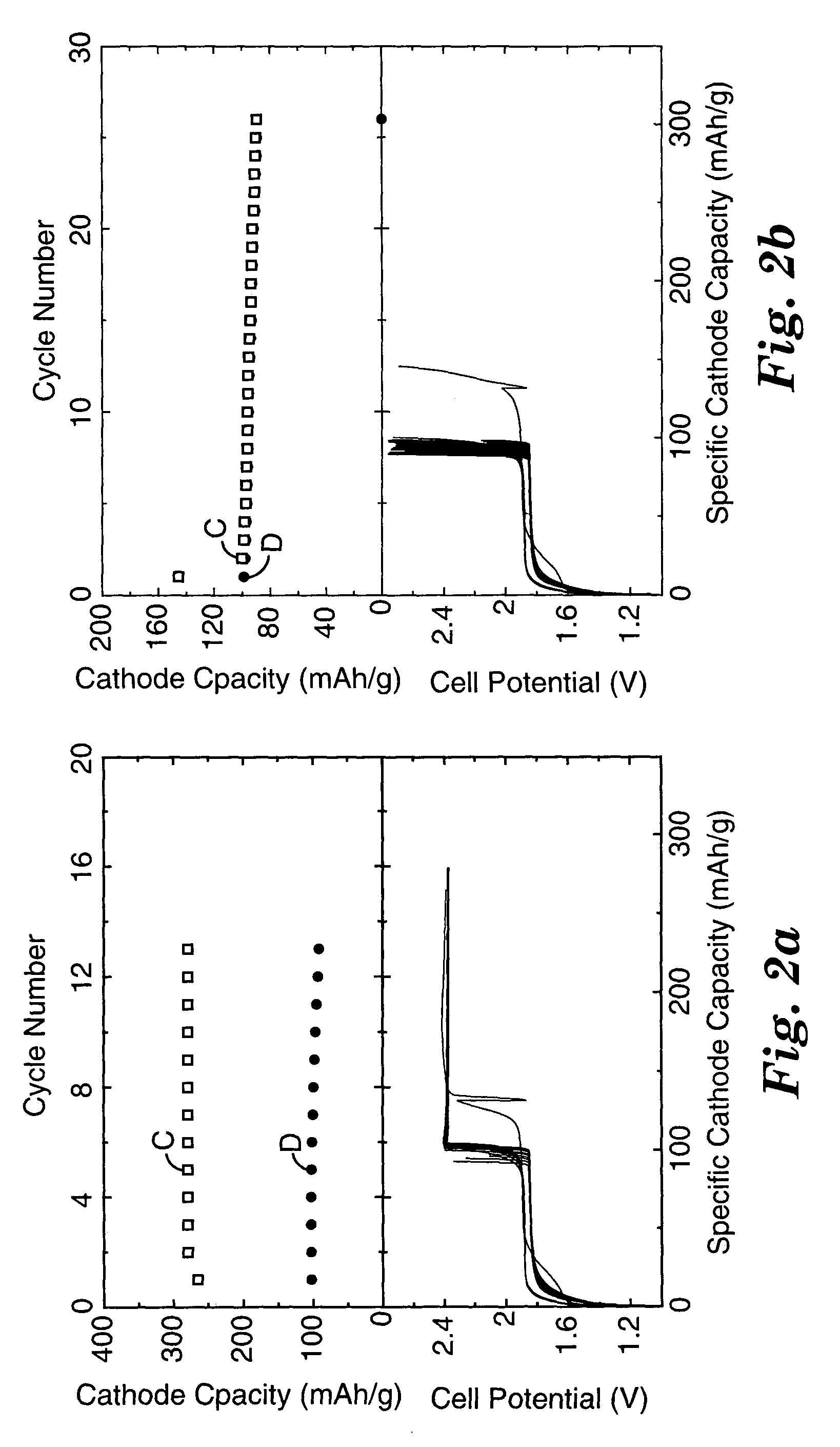Redox shuttle for rechargeable lithium-ion cell
a lithium-ion cell and rechargeable technology, applied in secondary cells, non-aqueous electrolyte cells, cell components, etc., can solve the problems of degrading or otherwise losing effectiveness, offering inadequate repeated overcharge protection, and being poorly suited for use with other lithium-ion cell chemistries, and achieve excellent repeated overcharge stability
- Summary
- Abstract
- Description
- Claims
- Application Information
AI Technical Summary
Benefits of technology
Problems solved by technology
Method used
Image
Examples
example 7
[0062]A 2325 coin cell like that made in Example 4 was evaluated using a “C / 2.5” (two and one-half hour charge and discharge rate) test cycle. The results are shown in FIG. 7a and FIG. 7b, with FIG. 7b showing cycle-by-cycle cell potentials for four time spans during the course of the test. The shuttle exhibited excellent stability even after 200 cycles, and continued to provide a relatively flat charging voltage plateau even at 1440 hours. Following preparation of FIG. 7a and FIG. 7b, the cell has continued to be monitored. The cell has surpassed 3000 hours of cycling, and the shuttle continues to exhibit excellent stability and provide a relatively flat charging plateau.
example 8
[0063]A 2325 coin cell similar to the Example 1 cell was prepared using a two-stage crimping procedure that provided a tighter seal. The cell employed a Li4 / 3Ti5 / 3O4 negative electrode and contained as the electrolyte 0.8 M LiBOB in a 1:2:1:2 molar ratio mixture of PC:DMC:EC:DEC. The cell was subjected to overcharge / discharge testing at 55° C. The results are shown in FIG. 8a and FIG. 8b, and demonstrate excellent shuttle stability after 45 cycles and about 1200 hours.
example 12
[0067]FIG. 10 shows the maximum solubility of 2,5-di-tert-butyl-1,4-dimethoxybenzene in various molarity solutions of LiPF6 or LiBOB lithium salts dissolved in a 1:2 (by volume) mixture of PC:DEC, a 1:2 mixture of EC:DEC, a 1:2 mixture of PC:DMC or a 1:1 mixture of PC:DMC. Solubility limits were determined visually, after extended mixing. FIG. 10 shows that in all cases the shuttle solubility decreased as the lithium salt concentration increased, and that the shuttle solubility did not differ greatly in solutions of LiPF6 or LiBOB having the same molarity.
[0068]Further testing was carried out in coin cells made using 0.2 M 2,5-di-tert-butyl-1,4-dimethoxybenzene and 0.5 M LiBOB in 1:2 PC:DEC. The cells were charged to a voltage plateau corresponding to operation of the shuttle (viz., the potential at which the shuttle became oxidized at the LiFePO4 positive electrode, in this case a potential of about 3.9 V vs Li / Li+) and then the current was sequentially increased. FIG. 11 shows tha...
PUM
| Property | Measurement | Unit |
|---|---|---|
| electrochemical potential | aaaaa | aaaaa |
| temperature | aaaaa | aaaaa |
| diameter | aaaaa | aaaaa |
Abstract
Description
Claims
Application Information
 Login to View More
Login to View More - R&D
- Intellectual Property
- Life Sciences
- Materials
- Tech Scout
- Unparalleled Data Quality
- Higher Quality Content
- 60% Fewer Hallucinations
Browse by: Latest US Patents, China's latest patents, Technical Efficacy Thesaurus, Application Domain, Technology Topic, Popular Technical Reports.
© 2025 PatSnap. All rights reserved.Legal|Privacy policy|Modern Slavery Act Transparency Statement|Sitemap|About US| Contact US: help@patsnap.com



